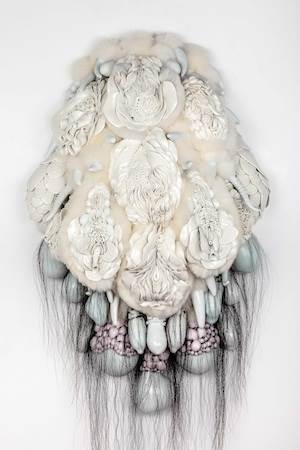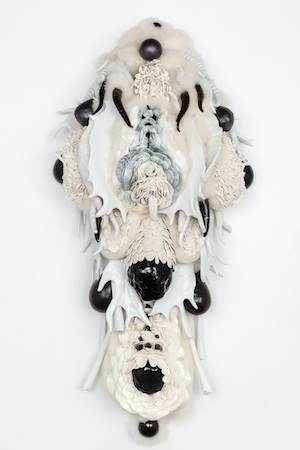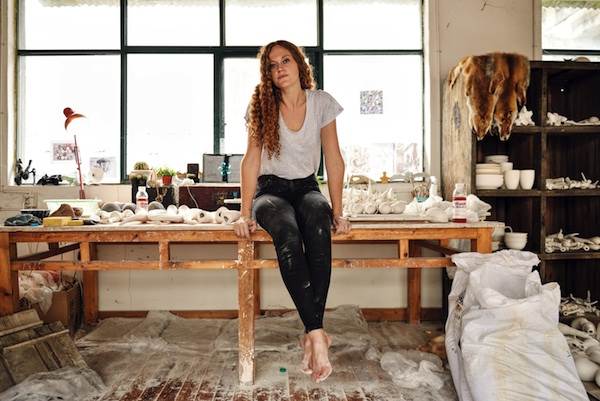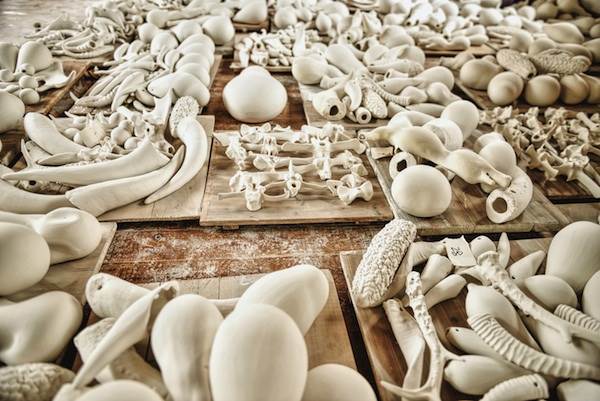Her pieces fuse the rot and stuff of ‘us’ (hair, teeth, flesh) with delicate orbs, spikes and droplets of porcelain. New work and some pieces that were shown in the Adelaide Biennial will now form her first solo show at Jan Murphy Gallery. This series represents more than three months exploring new bodies, glaze surfaces, mould making techniques and the creation of thousands of hand built and slip-cast components. As we go to print Kitson is in the latter stages of her build; bronze casting, glass blowing, silversmithing and woodcarving.
Inching toward the New Year the artist will continue down her fascinating path to a commission in China, a residency in Indonesia and Taiwan, and then a curatorial opportunity in the western desert, Australia. This itinerant lifestyle took hold in 2011. Following an ArtsNSW residency between The National Art School and Tsinghua University Academy of Art and Design Beijing, she stayed on as a studio assistant to Lin Tianmiao, an artist she greatly admired and an important mentor. Kitson has since exhibited in solo and group shows at 798 Art District Beijing, Today Art Museum and Qingdao Sculpture Art Museum. Going between her Jingdezhen studio where ‘time never stands still’, and in Hill End where she revels in the ‘silence and solitude of the Australian bush’, is a divergence crucial to the ongoing development of her practice.


It is clear you take pleasure in contrasting textures. Is there poetry in this as well as stimulation?
Definitely, material is important to me. I consciously choose certain animal pelts or hides to contrast against the porcelain and evoke a sense of warmth and security, familiarity and certainty. Though, like the flip side of the same coin I use teeth and echidna quills to represent the harsh and brutal potential of nature.
What do you learn by considering mortality?
I learnt at a very early age to appreciate life you must understand death. I accepted death at an early age and have explored it for the duration of my practice to date. Like life itself, my practice is a process of evolution; through drawing on materials that connote a certain meaning and hold hidden deeper sinister meaning.
When you gather are you ‘communing’ with the objects or is it more clinical?
I have a scientific approach to collecting. I collect specimens, brumby pelvises, kangaroo vertebrae, bore teeth, emu feathers, fox pelts, goat hides, husks and tusks both road kill and animals that die naturally on properties around western NSW and the Central Coast. There is quite a clinical approach to the way I collect, I spend hours gathering and sourcing objects to make moulds of, dip in wax or encase in porcelain. For me walking the land ‘collecting bones’ is an integral part of my practice where I am exposed to the conditions and the brutality of death and the presence of life in nature. Then upon return back to the studio I place the fresh carcasses on an ant’s nest for the remains to be stripped by the ants, exposed to the weather and bleached by the sun.
The term ‘shamanism’ has been used to describe your work, how do you relate to it?
There is a sense of shamanism; a collection of absurdities from nature that become hybrid taxonomic collections representing the impermanence and transience of life. There is also a process of alchemy in the way I develop techniques – heating a pin over a tea light and melting a hole in the surface of the paraffin wax, and inserting individually, strand by strand of horse hair or binding the Chinese silk thread, like a process of ritual, around the objects layer by layer.
Aside from the result, what is the importance of your ‘hands-on’ process?
The work is painstakingly meticulously hand formed to create objects that push the boundary of materialism and diminish stereotypes about the age-old divide between craft and fine arts. I use material like wool and techniques such as knitting that are typically associated with ‘feminine handy crafts’ but I re-contextualise the material and place it on a new platform.
Jan Murphy Gallery
8 to 29 October, 2016
Queensland
Of all things; the ever presence, no II, 2016, Southern ice porcelain, Jingdezhen porcelain, Taiwanese porcelain, Merino wool, paraffin wax, horse hair, marine ply and treated pine, 150 x 60 x 32cm
All but a series of moments, no II, 2016, Southern ice porcelain, Jingdezhen porcelain, Merino wool, paraffin wax, resin, marine ply and treated pine, 130 x 65 x 30cm
Courtesy the artist and Jan Murphy Gallery, Queensland





